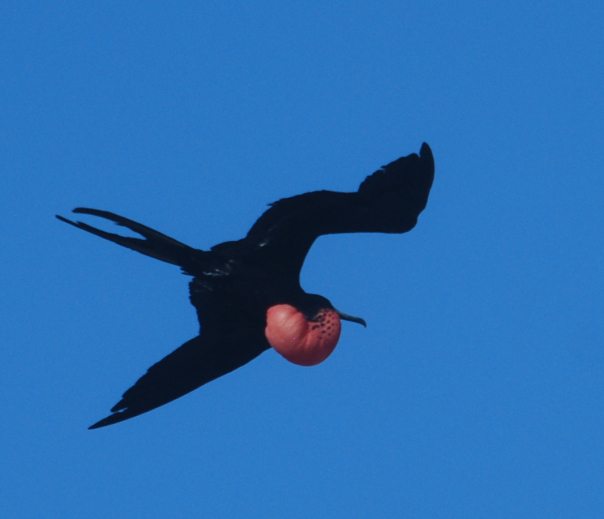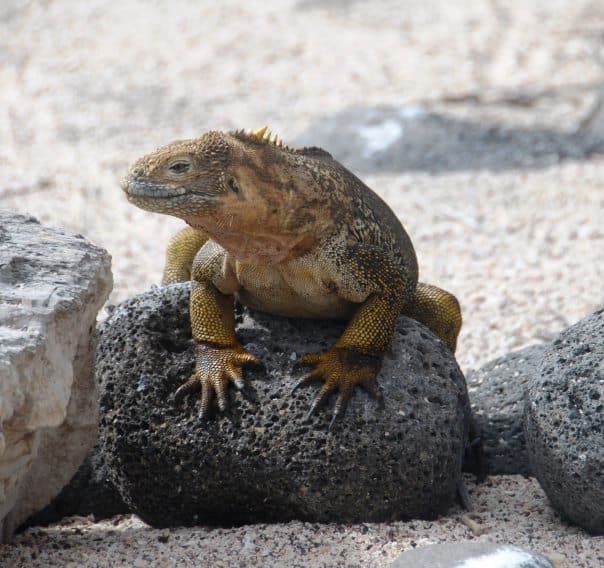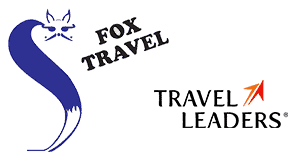Fox Travel loves our clients. They always give us amazing feedback, and from some, we even get the privilege of them allowing us to share their personal experiences through our many platforms. Robyn Bushong, a long-time client of ours who has contributed before, said we can share her wonderful experience on the Silver Seas Silver Galapagos in August. We hope you enjoy reading this Galapagos Islands trip review as much as we did.
The Galapagos Islands

Dorothy Trevino (right) and I are on our Galapagos adventure this summer.

Silversea Cruises’ 100-guest Silver Galapagos was our “home” for seven days as we explored the islands of the Galapagos. (Photo by Robyn Bushong.)
“Ladies and Gentlemen… welcome to Silversea Cruises’ Silver Galapagos. On behalf of our expedition team, we’re delighted to have all of you with us and look forward to sharing this incredible destination – The Galapagos Islands with each of you. Please know, however… You’re here for Summer Camp. Not a vacation!”
And with that statement, my dear friend, neighbor, and traveling companion, Dorothy Trevino, and I looked at each other and said: “Wow…let the Galapagos Islands adventure begin!” That introduction was made during the Mandatory Welcome Briefing – just a few hours after boarding Silver Galapagos. Our expedition team (comprised of eight highly-trained Naturalists/Expedition guides from the Galapagos region and Ecuadorian natives) followed that introduction with an in-depth overview of our upcoming voyage and the Galapagos National Park rules. We learned that the animals have no fear of humans (e.g., sea lions, red- and blue-footed boobies, great and magnificent frigatebirds. (It’s important to note that the two species of frigatebirds are distinguished by size and the color of the sheen on their plumage.

The great frigatebird is is in flight. During the breeding season,, the males regularly inflate the thin, red, gular sac on their throats with air. These fleshy, red balloons are used to show off to and attract females during the mating season. (Photo by Robyn Bushong.)
The great frigatebird’s plumage has a green sheen, while the magnificent frigatebird – also larger, has a purple iridescence in the sunlight.) If you’re a bird lover too, articles like “Where do snowbirds go” might pique your interest.
In addition, we could expect to see albatross, Galapagos penguins, as well as other bird species, marine and land iguanas,

This was one of many land iguanas “on patrol.” (Photo by Robyn Bushong)
and giant Galapagos tortoises. So our opportunities for photographs – up close and personal – would be very probable. We learned we’d have a minimum of two excursions a day, plus opportunities for snorkeling (with wet suits and gear provided) and kayaking expeditions. We learned that the ship would anchor in open water and we would be transported to each island by Zodiacs (very sturdy, heavy rubber boats with a capacity of 12-16 adults.) Park rules included using no flash with photographs, not touching nor feeding the animals/wildlife, nor allowing animals to touch us. We had to be prepared for both wet and dry landings (closed-toe water shoes for wet landings) and sturdy walking/hiking shoes for dry landings. Our “nature walks” (a misnomer – more like strenuous hikes) would be on uneven trails/surfaces comprised of large/small lava rocks which required very sturdy shoes.
Yet before we began this journey, we first learned that this archipelago was a “living museum of evolutionary changes. Free and fearless animals – different from any others found elsewhere.” Most importantly we learned that in 1831(some history books say 1835), Charles Darwin – a British geologist and “enthusiastic amateur naturalist” joined the voyage of the H.M.S. Beagle as an “unpaid companion” and geologist. It was this experience – combined with his detailed study and assessment of collected specimens over the next twenty years – that led to his theory of the Origin of Species – i.e. the Theory of Evolution. Darwin recorded – during the five weeks that the Beagle sailed between the islands – that “the natural history of this archipelago is very remarkable: it seems to be a little world within itself; the greater number of its inhabitants, both vegetable and animals, being found nowhere else.” It’s been said that “all who choose to make this unforgettable trip can confirm his observations and studies.” UNESCO declared Galapagos a World Natural Heritage Site in 1978; and a World Biosphere Reserve in 1985. It’s also important to note that these islands (the archipelago consists of 13 large islands, 6 minor ones, and more than 40 islets that lie approximately 600 miles west of the coast of Ecuador) appeared from lava eruptions that would come from the bottom of the Pacific Ocean and rise as much as 2,600 feet. Lava – from more than 2,000 craters – has continuously altered the terrain in this region.
Following the Welcome Briefing and the incredible history lesson about Darwin, Dorothy and I returned to our stateroom, stood on the balcony with a glass of champagne,, and toasted to a wonderful, exciting 7-day North Central itinerary (June 17-24, 2017) in The Galapagos Islands… a “world” unto itself!
Because we were right on the equator, the temperatures varied little between summer and winter (technically now winter – south of the equator.) Daily temperatures averaged between 75-80 degrees F., with not that much humidity; water temperature – low 70s F. But we were warned: the sun is hot and one can burn quickly.
Our adventure began promptly at 7 am, Sunday morning, June 18. Life jacket and backpack on; sun screen on our faces, dressed in long-sleeved “safari-type” shirts and safari shorts, with a wide-brimmed hat andsunglassess; camera and water bottle in hand – we were off to Genovesa Island – aka “Bird Island,” Darwin Bay and Prince Philip’s Steps (so named because the Duke of Edinburgh fell on the uneven steps during his visit to this island in1965.) We were looking for great frigatebirds, brown pelicans, sea lions, red-footed

A red-footed boobie. (Photo by Robyn Bushong.)
boobies, Nazca boobies, fur seals, and Galapagos sea lions. Our 1-mile “nature walk” took almost an hour as we ascended/descended the steep and uneven Prince Philip’s Steps and hiked over uneven terrain of volcanic rocks. Most impressive were the red-footed boobies – characterized by their red feet, beautiful blue beaks and colorful faces. That afternoon, we embarked on our Zodiac for a trip to Darwin Bay to view more wildlife. The informative and lively evening briefing was at 7 pm. Dinner that evening was very special as Dorothy and I had been invited to join the Hotel Director as his guests for dinner in The Restaurant. A delightful evening.
On Monday, our adventure continued to Santiago Island and Seymour Norte in the morning, and that afternoon to Bahia Sullivan. Following a wet landing, we hiked/walked on lava rocks for an hour and saw sea lions dozing on the sunny beach, blue-footed

Blue-footed boobie. (Photo by Robyn Bushong.)
boobies performing their courtship dance known as “sky-pointing”, and land iguanas on patrol. Experienced snorkelers had their first opportunity for deep snorkeling to explore underwater marine life. For Dorothy and me – we kayaked this afternoon. She – a very experienced, long-time kayaker; me – only my second time ever! Needless to say, it was exciting, especially since you transferred from the Zodiac to the two-person kayak in open water – with the “goal” not to fall into the ocean. I was in front trying to establish a rhythm to our strokes and not panic about upcoming rocks and kayaks in front of us. (Dorothy later said the “biggest mistake she made was showing me how to ‘brake’ as that’s all I wanted to do, for fear we’d run into something.”) We survived and it was fun!
For Tuesday, we were on to Rabida Island, Eden Islet, and Santa Cruz. Most impressive with this island was its spectacular beauty: red/maroon sandy beaches contrasting with the turquoise-blue waters, prickly-pear cactus against a backdrop of green Palo Santo trees, and of course…wildlife – including Darwin’s finches, lava lizards, and Galapagos mockingbirds. Exercise today consisted of a moderate-paced nature walk, snorkeling, swimming, and kayaking. Following our daily briefing, Dorothy and I were dinner guests of our favorite expedition guide, Karinna Lopez.
Wednesday morning we were off (at 7:15 am) to the San Cristόbal Tortoise Breeding Center at La Galapaguera at Cerro Colorado, San Cristόbal Island. (As an aside… we never got to sleep past 5:45 –6 am to have breakfast before we left on our morning adventure. This was, indeed, “Summer Camp”!) After a short Zodiac ride from the ship, we docked in Puerto Baquerizo Moreno, an interesting little port filled with dive shops, al fresco cafes, and hostels. The sea lions were so tame. We’d see them sleeping in the shade on the benches next to the docks, with people sitting next to them. Or, we’d see the sea lions dozing on the back of small boats

Sea lions resting on the back of motor boats were a common sight in the harbor of Puerto Baquerizo Moreno (Photo by Robyn Bushong.)
docked in the harbor – so not afraid of humans! After a 45-minute motor coach ride to the Breeding Center, we walked through the Center and saw tortoises ranging from a hundred years old

What an incredible opportunity to be almost at eye level with these giant creatures. (Photo by Robyn Bushong.)
to just a few days old. Our guide provided an excellent overview of the Breeding Center. It was also pointed out how much work had been done since 1950 by the dedicated Galapagos National Park Service rangers and scientists of the Charles Darwin Research Center to bring back the Galapagos tortoise from almost extinction (due to hunting and competition from introduced animals on the islands.) When we got back to the small seaside town, we had time for coffee and to do a little shopping. Very nice! We opted not to take the afternoon hike to Punta Pitt. Considered “very strenuous with numerous inclines/declines on volcanic rock”, and since we were assured by Karinna, that we wouldn’t miss seeing anything that we hadn’t already seen, we opted for a workout in the ship’s gym and an afternoon nap.
Our Thursday expedition again began at 7 am – via kayak near Gardner Bay, San Cristόbal Island. Dorothy is such a skilled kayaker and “captain.” We kayaked in and out of the coves – in crystal clear waters – and saw numerous sea lions, birds, and marine iguanas – basking in the early morning sun. There were eight kayaks in our group and it was a delightful outing. When we got back to the ship, I had the opportunity to take a Zodiac back to the beach (a red sand beach) and take photographs of hundreds of sea lions. I was so close to these magnificent creatures. It was just amazing and truly a once-in-a-lifetime opportunity to see these magnificent creatures in such a natural habitat. Our afternoon excursion was to Punta Suárez at the western tip of Española – the oldest island in the Galapagos.

Our group takes a break to enjoy the stunning vistas of Punta Suarez, situated on the western tip of Espanola – the oldest island in the Galapagos. (Photo by Robyn Bushong.)
As we came ashore, we were facing stunningly-beautiful sheer volcanic cliffs teeming with swallow-tailed gulls, Nazca boobies, Waved albatross, mockingbirds, and the occasional Galapagos hawk, as well as other seabirds. This afternoon’s 2 1/2 mile hike around the island was on large lava rocks – and it was challenging. But we made it.

A “juvenile” Nazca boobie. ( Photo by Robyn Bushong.)
Highlights were photographing nesting birds – such as Nazca boobies and their “juveniles” – identified with white fuzzy feathers, not old enough to fly, and still depending on their parents for food. Also, took lots of photos of both the marine and land iguanas and of course… more sea lions. After the evening briefing at 7 pm – we went back to our stateroom, where we toasted to another great day, relaxed, enjoyed a delightful room service dinner, and watched movies. (We both agreed: We should have done this trip when we were 60 instead of 70!!)

Without question, the magnificent sea lions – with such expressions on their faces – were our favorite of all the creatures we saw. (Photo by Robyn Bushong.)
Friday was our last day on the Galapagos Islands. Our Zodiac docked at the pier in the small town of Puerto Ayora on Santa Cruz island. From there, we took a 30-minute motor coach ride to the Fausto Llerena Breeding & Interpretation Center outside of town where we saw giant Galapagos tortoises in their natural habitat on a private farm. Such prehistoric-looking creatures! And to be right next to them – leaning down and almost at eye level as you take photos – amazing! After our tour here, we went back to town, walked around, and bought gifts to bring back home – especially chocolate and coffee gifts. (It’s important to note that Ecuador is known worldwide for its outstanding chocolates – made from cocoa grown in the Ecuadorian mountains. Also, the country is well known for its exceptional Ecuadorian organic coffee.) These were two of the most popular souvenir items – especially the chocolates. That afternoon – the final excursion – was to Plaza Sur – a small island near the eastern coast of Santa Cruz – to view the very unique giant prickly-pear cactus that grew atop an unusual mat-like ground cover of reddish Vesuvius (aka Galapagos carpet plant or sea-purslane), and as well to see marine iguanas and, for the last time, our favorite sea lions.
As you can tell, we didn’t spend much time on board – except for meals (either in The Restaurant, The Grill, or room service.) The most fun experience was lunch at The Grill on Deck 5Aft. (Deck 6 was the top deck of this small 100-guest vessel.) At noon every day, we would be entertained with live music by Braulio, our talented singer andkeyboardd musician who had everyone – including the crew – singing along with him. His lively entertainment at lunch, the fun and friendly Grill staff, and an exceptional buffet, with daily blackboardd” specials – made our al fresco lunch the highlight of our onboard experience.
We had to vacate our staterooms by 6:15 am Saturday. Following breakfast, we debarked – again in Zodiacs – to the pier at San Cristobal. From there, it was a 5-minute drive to the airport. It was a total 4-hour flight from San Cristobal to Quito, Ecuador. (We had one stop in Guayaquil where many of our fellow travelers deplaned for flights back to their final destinations.) We arrived in Quito at about 4:30 in the afternoon, but our UA flight didn’t leave till 12:30 am Sunday, so we had plenty of time (understatement) to explore the airport. (International flights are overnight flights and access to a VIP private lounge is limited to max 3 hours before your international departure.) And we must say… it was an exceptional airport with lots of restaurants, shops; and nooks and crannies where you could put your feet up and read and rest. We arrived at IAH on time at 5:50 am Sunday, June 25. Having Global Entry and no checked luggage, we zipped through customs/immigration and were in our waiting transportation within 15-20 minutes of deplaning.
Do we recommend this itinerary? ABSOLUTELY! Many of the guests on board were family groups – multi-generational families with young children, teens, aunts, uncles, parents, and grandparents. There were two large groups of 11 and 14 each. Also, onboard were several families traveling with teens celebrating their high school graduation with a trip to The Galapagos. Most of the guests were early 40s to mid-60s. There were a few travelers older than us and everyone made the hikes and excursions. One gentleman from Switzerland was 84 and in excellent physical condition. Again, personally…Dorothy and I would have enjoyed this adventure more if we had experienced this itinerary a decade earlier. It was physically challenging. We also realized that we didn’t have to take part in each of the 2-3 daily expeditions offered – but for the most part – we did – ’cause we didn’t want to miss anything!
We both realized just how fortunate we were to have had this incredible opportunity to explore Darwin’s Living Laboratory of Evolution: To see a giant tortoise feeding upon the only land it has ever called home. To see first-hand flora and fauna endemic to these volcanic islands lying in the vastness of the Pacific Ocean. To stand next to wildlife that has no fear of humans. And, to witness just what happens when the “outside world doesn’t interfere with the wonders of nature.” Yes! This is an amazing adventure that is truly a once-in-a-lifetime and should not be missed. The Galapagos Islands… A “World” Unto Itself!
To view the rest of Robyn’s article about the Galapagos Islands, please view her blog in its entirety, originally posted.
Contact Us!
Did Robyn’s blog inspire you to research your Galapagos adventure? Contact Fox Travel at 281-363-0808.
If you would like to share your vacation photos or blog about the Galapagos Islands with Fox Travel, please email it to [email protected] We would love to share it!




